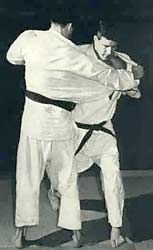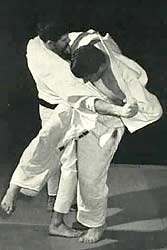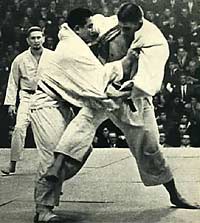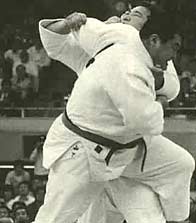The Classical O-Soto-Gari Judo Throw
Part 1: It Doesn't Work

by Ben Holmes
Editor's Note: This is a two
part series discussing the effectiveness of the classically taught major
outer reaping judo throw, O-soto-gari. Part 1faults the classical method
while a rebuttal to this criticism follows in Part
2. In a follow-up article, the jujutsu and combat roots
to this same technique will be illustrated.
Introduction
O-soto-gari (major outer reaping throw) is one of the most basic throws
in judo, and is also taught in various forms in jujutsu, daito-ryu,
karate and in many other martial arts.
In judo, it is used against opponent in all sizes and is a principal
point-getter in judo matches. It can be used against an opponent who
is standing or moving forward, backward or to the side, but to make
it work takes full commitment. When executed properly this throw dumps
the opponent backwards to the ground.
How the Classical O-Soto-Gari Throw Is Taught
(1) Begin in the right natural posture.
(2) Make your opponent step forward with his right foot (see the photo
above) by pulling him gently to his right front corner. Put your left
foot outside his right foot to break his balance to this right back
corner by pulling him toward you with your left hand and pushing him
backward with your right.
| (3) Lightly raise
your right leg and swing it past your opponent's right leg. Clip
his thigh hard from behind with your thigh. At the same time,
pull down hard with your left hand and push toward his right back
corner with your right hand. Your opponent's legs will fly up
and he will fall directly backward. |

|
The Reality
It has long been a pet peeve of mine that o-soto-gari is rarely taught
as it is actually performed. All of us are familiar with the "classical"
form of the technique, as described and shown above. And as many times
as we practice that form, when it's time to actually use this throw,
in either randori (free-style practice) or shiai (contest), it's never
done this way!! Interestingly enough, o-soto-gari is generally roughly
the third leading throw used in competition, so it's not by any means
a rarely used technique. And yet, it's rarely taught the way it's actually
performed!
My first assertion: This "basic" (or "classic")
form of o-soto-gari doesn't work. I'm fully aware that most Judoka (judo
practitioners) reading the previous sentence will now think to themselves
that I must know very little judo to make a statement like that. However,
Phil Porter (judo author and referee who won the 50-55 class competition
in the 1975 National Masters Tournament and served at Chairman of the
U.S. Judo Federation) makes a very similar statement concerning "classical"
o-soto-gari, so I'm in fairly good company. If you are facing someone
who knows no judo, and can be manipulated easily by you, then yes, this
version of o-soto will work. But if you are attempting to make this
work against either a resisting opponent, or a knowledgeable opponent,
sorry, it won't work.
This is rather easy to demonstrate -- simply start looking for the
"classical" version of the technique. You won't see it. It
doesn't occur at all unless you are watching the 6-8 year old yellow
belts. When you get to serious randori and shiai, the "classical"
form of o-soto-gari disappears completely.
 |
 |
Now, we saw in the above photos how Anton Geesink (Europe's most famous
judo champion, world title holder and Olympic gold medallist in the
1964 Olympics), demonstrates and teaches o-soto-gari, let's examine
how he performs o-soto-gari in competition. As you can see in this photo
on the left, it would appear that Anton Geesink forgot everything he
ever knew about o-soto-gari, since he's doing what is virtually a different
throw altogether. Instead of stepping forward with his left foot, he
has evidently either left it in place, or even stepped back in order
to get a 45 degree "angle of attack" on his opponent. It looks
like it might even be the beginning tsukuri (moving the body into a
position to execute a throw) of ashi guruma (a hip-throw that utilizes
a foot sweep), but in this form of o-soto-gari, uke (the person taking
the fall) will be thrown backward.
To the right, you can see Yasuhiro Yamashita, who authored a book on
o-soto-gari, executing the dynamic form of o-soto-gari. And yet, in
his book on the subject, this was relegated to a couple of pages as
a "variation". Then throughout the book, he taught the classical
version, and all the competition photos showed the dynamic form of the
technique!
The Principle Of Seiryoku Zenyo
One of the principles of judo is "seiryoku zenyo," commonly
translated as "maximum efficiency with minimum effort". Another
way to translate it, and a personal favorite of mine, would be: "best
use of energy".
My second assertion of this article is: The classical version of o-soto-gari
violates the principle of seiryoku zenyo. Below, I show in detail why
the classical version doesn't work. Here is a step-by-step discussion
of this premise.
Let's start with a step-by-step critique of the description of o-soto-gari
given at the beginning of this article.
(1) Begin in the right natural posture.
Comment: No problem yet.
(2) Make your opponent step forward with his right foot by pulling
him gently to his right front corner.
Comment: Now we have a problem. Why are you going to attack the leg
that has no weight on it? If you believe that you can exert enough pull
later on to force uke (the person taking the fall) to place his weight
on his right foot, doesn't this violate the principle of maximum efficiency?
(3) Put your left foot outside his right foot ....
Comment: Another huge problem... we are attempting to force uke backwards,
but then we place our driving leg in the totally wrong place to exert
any force! Take any six year old child, and ask him/her to push as "hard
as they can" against a wall, and they will naturally assume a 45-degree
"angle of attack" against the wall. If a six year old doesn't
have to be taught how to exert maximum force with minimum effort, why
did we forget it? (Think about the "driving" or rear leg of
a boxer doing a right cross, or a batter swinging a bat, or a track
and field sprinter coming out of the blocks... yep, they're all at a
45-degree "angle of attack.")
(4)...to break his balance to this right back corner by pulling him
toward you with your left hand...
Comment: In order to pull downward (to set uke's weight on the leg
you are attacking), you must be in a position that won't allow you to
exert any force to the rear... you must be "even" with, or
slightly behind uke's vertical line. This particular "pull"
must accomplish more here than in the version which follows. Here the
pull must actively set uke's weight on his right leg. In the version
which follows, the pull merely keeps the already-existing weight in
place. Which is a more efficient use of force?
(5)...and pushing him backward with your right.
Comment: With what force? What are you pushing against? Try stepping
right up to a heavy filing cabinet, and see how far you can push it.
Then set one or both feet behind you at a 45-degree angle, and see how
much easier the task is. "Maximum Efficiency with Minimum Effort"
is a very real principle that can accomplish things if followed.
(6) Lightly raise your right leg and swing it past your opponent's
right leg.
Comment: Raise your leg while you are standing on one foot? I sure
hope you succeeded in off-balancing uke to the rear, because if you
didn't, you're about to take a nasty fall. In the more dynamic form
of o-soto-gari, you'll also raise your leg, but your path to the ground
is blocked by uke.
(7) Clip his thigh hard from behind with your thigh.
Comment: You're attacking the leg that has only as much of uke's weight
on it as you've managed to pull onto it. If you've failed to pull enough
weight onto it, you are about to take a nasty fall.
(8) At the same time, pull down hard with your left hand...
Comment: As above, this is only possible if you are in the wrong position
to deliver effective backward force. The amount of pull required is
greater here in this version than in the more effective version. What's
more efficient?
(9)...and push toward his right back corner with your right hand.
Comment: This is at best, weak, and at worst, not possible. Notice,
that in the classical version, the pushing and pulling is done with
your hands, whereas in the more effective version, the pulling is still
done with one hand, but the pushing is done with your whole body, driving
off a strongly set leg. What's more efficient?
(10) Your opponent's legs will fly up and he will fall directly backward.
You will remain standing.
Comment: You will remain standing, which won't happen in the dynamic
form of o-soto-gari. And in order to remain standing, and to execute
this classical version, you have completely failed to deliver the force
needed, at the appropriate locations, with maximum efficiency. It is
also very easy to resist this classical version... so easy, in fact,
that this classical version is never seen against a knowledgeable, resisting
opponent.
The Dynamic O-Soto-Gari
Now, on to the dynamic, better way to do o-soto-gari, staying within
the principles of Judo.
First, let me identify the basic elements that will be important.
(1.) We want to attack the leg that has the majority of the weight
already on it. Generally, this means you'll attack the rear leg, and
in general, against a right-handed opponent, this means his left leg
(although I'll give a right-side example).
2. We will want to have a 45-degree "angle of attack." This
means that instead of stepping forward into your uke, your first step
will more than likely be backward. This is the largest difference between
the two types, and the one most easily recognized. There have been those
who believe that this doesn't predate "Olympic" judo, but
here's a series of photos from 1905 showing a large space between the
driving leg and attacked leg: Old o-soto-gari -- not much of a 45-degree
angle, but certainly not the current practice of putting tori's (the
thrower's) left foot next to, and alongside uke's (the person being
thrown) right foot.
3. Instead of pushing with the right hand, we will be "setting"
our entire forearm into uke's chest. This creates a solid "connection"
between uke and the forward momentum of our whole body. Much more effective
than "pushing" with the right hand!
4. Somewhat more esoterically, this is a "driver," not a
"roller" throw (see anything by Phil Porter or Geof Gleeson
on these concepts. Gleeson is the finest original thinkers on Judo theory
who extensively studied the worlds greatest champions of Judo to learn
what they did.). Your attack will not be from the front of uke towards
his back, but from uke's side to his other side.
To put this effective version of o-soto- gari together, you'll wait
until uke has stepped backward with his right foot. At that time, you'll
step backward and slightly to the right with your left foot. At the
same time as you've stepped backward, you'll be slamming your right
forearm against uke's left side chest, and pulling downward with your
left hand (your right arm looks like it's delivering an uppercut to
uke's chin or ear). You'll now reach out with your right foot (you are
now leaning on your left foot with a 45 degree forward lean), and attempt
to "hook" uke's right knee. Then just "drive" forward...
although notice that your "forward" direction is actually
more sideways by your uke's viewpoint. Very common at this point, by
the way, is the need to "hop" forward to maintain the optimum
45-degree angle of attack (maximum force).
|
In the Ippon Masterclass "O-soto-gari," by Yasuhiro
Yamashita, the following series of photos appears, and Yamashita
captions it, "One of the finest O-soto-gari's ever photographed."
It shows Angelo Parisi (British Judo Champion who won three European
junior titles and won the bronze medal in the 1972 Munich Olympics)
throwing Shota Chochosvilli (Russian Judo Champion and gold medallist
in the light-heavyweight class in the 1972 Munich Olympics).
Notice the power generated by Parisi's "45-degree angle
of attack." This is the most efficient use of strength!
After demonstrating the ineffectiveness and failure to follow
a principle of judo, we must ask, does this mean that a classically
taught o-soto-gari has no place in modern judo? No, not at all.
The classical version is very easy to take a fall from. It doesn't
require the skill at ukemi (falling techniques) that the more
effective version requires. During the time that Judoka are acquiring
the falling skills needed at the higher levels of judo, they can
still learn the "demonstration" form of throws.
This sort of comparison between classical, and dynamic effective
versions, can be done for other throws as well. In many throws,
the classical version is the most effective version as well. De
ashi harai (foot sweep to the side following a unbalancing technique)
comes to mind here.
Judo is evolving, both for the good, and in some aspects, for
the not so good, and if you are not keeping up on new techniques,
and new methods of training, teaching, and doing Judo, then you
should look into finding out about these things.
|
As a side note: the term "classical judo" is more commonly
meant to refer to the entire repertoire of judo, including kata (prearranged
forms), atemi (striking techniques), kappo (resuscitation techniques),
and so on. It was used in this article in its more narrow sense to refer
to the style of throw, and it goes without saying that my comment that
"classical judo" doesn't work was referring to the narrow
sense of the term.
Here's a couple of photos from "Judo" by Sakujiro Yokoyama,
published in 1915. On the left you'll see a rather interesting form
of o-soto-gari. On the right, you'll see a "classical" technique.
I always enjoy showing it to Judoka who believe that old classical judo
is the best. Sometimes it's not. Give it a try next time you're in the
dojo (training hall). It was the original form of Seoiotoshi.
I hope I've given you something to think about the next time you're
teaching or practicing o-soto-gari. I don't believe that a Judoka should
make it past brown belt without a firm grasp of the difference between
the classical and the dynamic forms of o-soto-gari. They really are
virtually two different techniques, in my opinion, even though both
the International Judo Federation and the Kodokan recognize both as
the same throw.
Note: This two-part article originally appeared on the judo
website www.BestJudo.com. An edited version of the original appears
here with the permission of Ben Holmes.
About The Author:
Ben Holmes is a third degree black belt in Judo (promoted in 1981)
who has assisted Neil Ohlenkamp in teaching at the Encino Judo Club
for the last three years. Prior to that, he taught at his own school.
He first started teaching in 1975 at the 29 Palms Marine Corps Base.
Holmes teachers have included George Hamm (his original instructor),
Phil Porter, Rene Pomerelle, Paul Maruyama, Kenneth Kunniyuki and
Yoshi Uchida. His experience also includes training in Aikido. He
is the founder of the BestJudo.com
website.